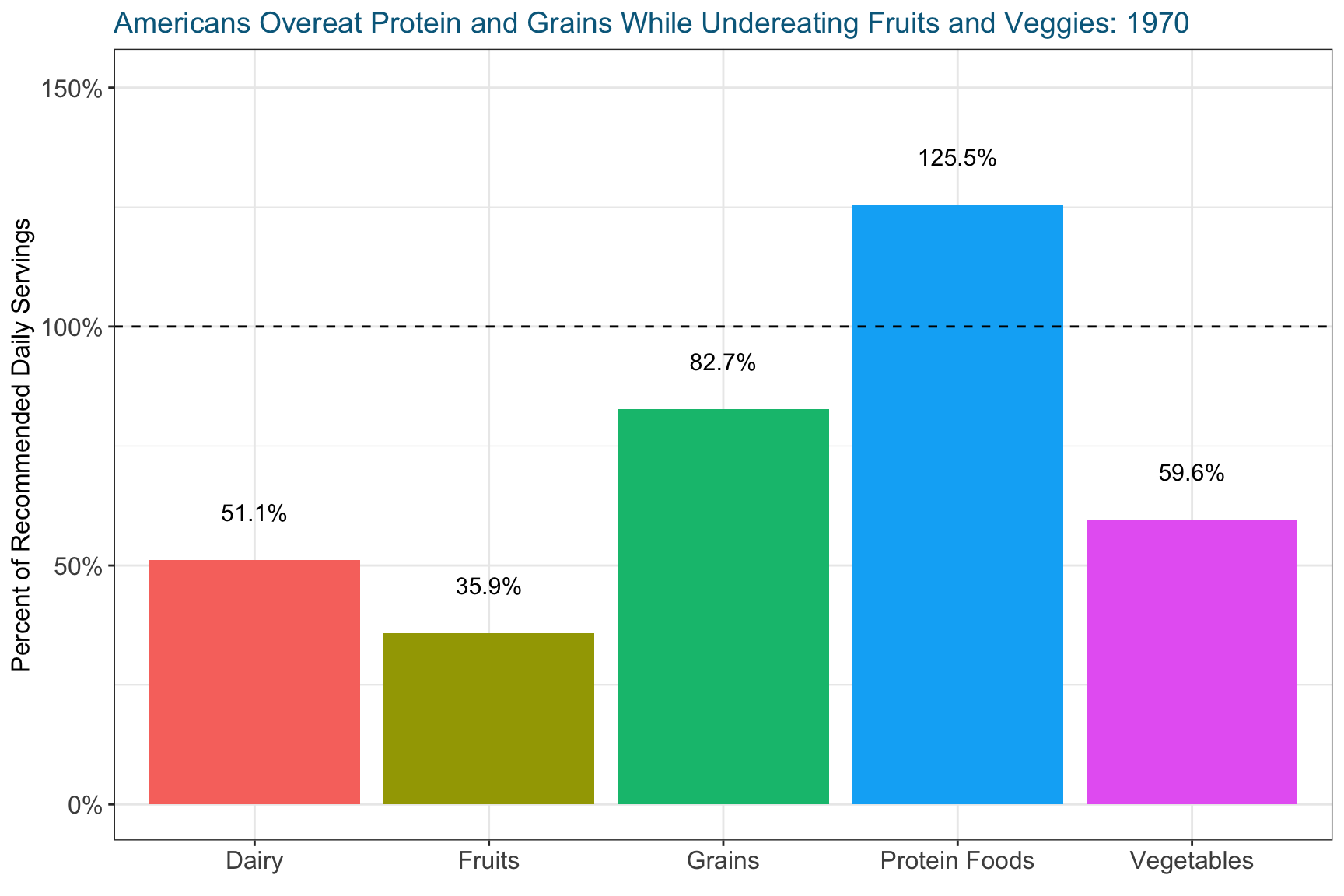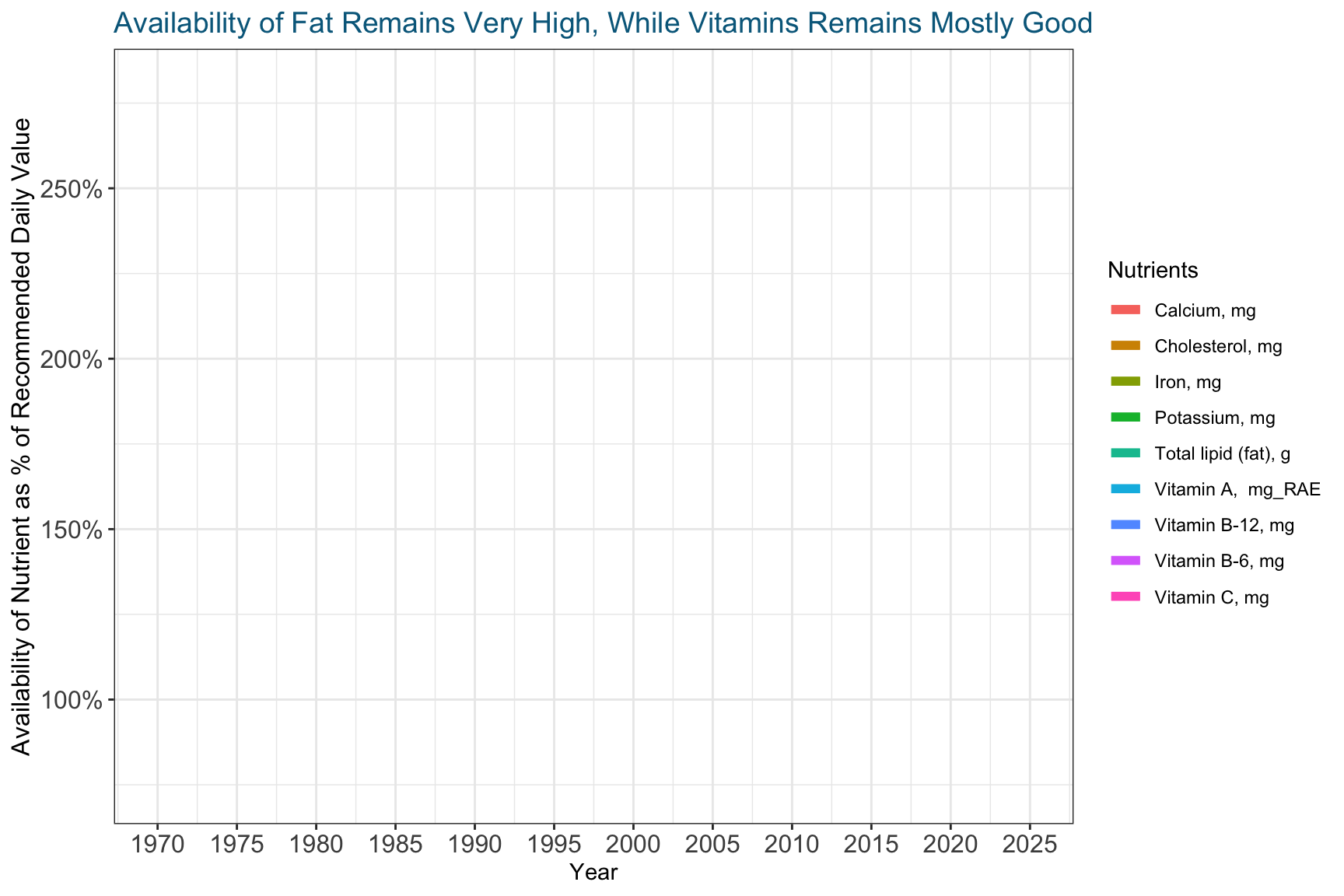
Inspired by the articles I linked in my previous post, (here, here, and here), I decided to investigate the USDA’s food consumption dataset to get an idea of how Americans’ diets have changed over time. I am also complementing this dataset with Harris Poll and Google Trends data. In the previous post, I demonstrated how I read the Excel files containing the USDA data into R and scraped the Harris Poll HTML tables. In this post, I am going to be sharing some interesting findings derived from my data.
Some Things Have Changed Over The Last 40 Years
The first section of this post discusses transformations that have taken place in how Americans eat, while the second section discusses a few trends that have remained constant over time.
Americans in 2015 Got Less Milk in their Fridge than Before “Got Milk” Campaign
The first thing that I found interesting about the data that the articles I cited briefly touched on as well, was the dramatic decrease in the consumption of milk since 1970. When I saw this trend, I was immediately puzzled. How was there such a dramatic decline over time when there were all those “Got Milk” ads? I swear that growing up, they were everywhere: bus stops, magazines and everyone was wearing the milk mustache, from Serena and Venus Williams to the Olsen twins, so what gives? It turns out after a little bit of research, I was able to uncover the truth about the “Got Milk?” ads. While largely popular, they were known to be highly ineffective, but they still ran the campaign for 20 years!

It is no secret that Americans’ diets are shifting as American society itself is also changing. For example, millennials are the most diverse generation yet in American history, with 44% of them identifying as non-white. Their younger siblings, Generation Z, will be even more diverse in all regards. Lactose intolerance is actually very prevalent in most parts of the world and as the majority of Americans come from more diverse backgrounds, it is possible that this could further contribute to declining milk consumption if people prefer to avoid it. Additionally, while there may not be conclusive evidence of higher rates of veganism, there is definitely more awareness around the issue of sustainable agriculture and the impact of food production on the environment. Increasingly, Americans are opting to make more plant-based choices as campaigns like “Meatless Monday” show. For example, demand for almond milk has exploded in recent years and a new range of products from oat milk to rice milk have come onto the market.
A different segment of the milk market, however, has actually grown: flavored milk. Americans are drinking more flavored milk than they were in 1970 in the form of chocolate and strawberry milk. These drinks with added sugar and artificial flavorings, typically marketed to children, run contrary to the “healthly milk” trend described above. While still much above 1970 values, these flavored milks have declined in consumption slightly since their 2010 peak, perhaps due to greater health awareness.

Unfortunately for the cow’s milk industry, these flavored milks though high growth, represent a very small part of the total milk market which is truly very much in decline. This example also illustrates the importance of always reading the units on a graph’s axes 🙂.

Chicken Has Become “Chic” To Eat
As mentioned above, Americans are becoming more aware of the impact of food production on the environment and opting for more sustainable alternatives. It is now well-known that beef produces more greenhouse gases than poultry and that substituting at least some beef portions with vegetables or poultry would have a positive impact on the environment. Many Americans are limiting red meat due to health concerns in addition to environmental concerns. Red meat consumption has been associated with an increased risk of heart disease (since most of the studies done to date have been observational in nature and thus not causal, the jury is still out but regardless the topic has made many headlines, some as dramatic as “Is meat killing us?”). Concurrent with red meat’s decline, chicken’s star has been rising. Chicken is generally cheaper than beef, but it has become trendy as celebrity chefs clamor to make their own take on the fried chicken sandwich and other classics. The trend is causing restaurants once known for selling beef to sell chicken as well. For the above reasons, as of the mid-2000s chicken has surpassed beef as America’s favorite meat. Other meat consumption has remained relatively unchanged. Americans still seem to be infatuated with bacon, which is having its own renaissance or “bacon mania,” popularized over the internet.

American Food is Diversifying Along With the American Population
As discussed above, America has diversified greatly over the last 40+ years. More immigrants from a wide array of continents have brought with them an increased interest in new foods, especially those from Mexico and Latin America. The below graph shows a handful of foods that have increased in per capita annual consumption. These are just a basket of foods available in the dataset, but I suspect if data was available on what types of dishes, rather than ingredients, Americans eat inside and outside of the home, we would also see an increase in diversity. As an Italian American, I am particularly proud to see that the country has fully embraced cooking with garlic. This is a cultural shift from the early 1900s, as seen in “It’s a Wonderful Life,” when Mr. Potter derides Italians as “a bunch of garlic eaters” to George Bailey. We are now a nation of garlic eaters!

Additionally, taking a look at the imports of herbs and spices shows that they are more diverse than ever. Spices are often key to making a dish authentically and while the USDA foods database may not encompass every type of food that would be interesting to view trended over time, the spice data gives us more clues as to what people are eating. Imports of the spices on the below graph have especially taken off in the last 10-15 years, much outpacing total population growth over the same time period. The spice that actually grew the most in percentage terms was ginger, at 2,987% over the last 40 years, but is not pictured because it dwarfed the other spices and made it difficult to see their trends. The popularity of ginger is probably due in part to its myriad health benefits.

Freshness and Fiber Lead Purchasing Decisions, but Generations Diverge for Other Factors
The findings from the USDA data can be compared with poll data to try to uncover the underlying causes of the food trends. Data from a Harris Poll taken in 2014 regarding the types of things Americans look for when purchasing food shows that Americans these days value freshness, fiber, and whole grains the most with 89%, 80%, and 77% respectively indicating that these characteristics are “important” (i.e. “Very important” or “Somewhat Important”) in their purchasing decisions.
(One thing to note about the Harris Poll data is that they do not release margins of error because they believe they are “theoretical” and can be misleading. For this reason, my graphs below do not illustrate or include sampling error. The reader should be aware that when comparing percentages between groups, small differences may not actually be statistically significant.)

Looking at the USDA data, we can see that over time, Americans have been consuming more foods in the “fresh” category and less foods in the “canned” category of fruits, vegetables, and seafood. (Unfortuntely since the mid-2000s, fresh vegetable consumption has been decreasing, although it is still above pre-1990s values.) This is interesting since for many years, humans had been searching for ways to preserve food for longer periods of time. Canning had been a breakthrough and housewives in the 1950s felt liberated by no longer needing to always prepare food fresh.

Over time, Americans’ fascination with canned food has been reversing, translating into a higher demand for “fresh” food. Americans have been demanding greater transparency into what goes into their food and wanting to know more details about its source. To meet this demand, Farmer’s Markets have sprung up all around the country as well as restaurants which list their producers by name and claim to “source locally”. Popular culture has poked fun at the transparency in sourcing trend, like on the show Portlandia, where a couple out to dinner demand to see the “papers” of a chicken named Colin to ensure he lived a happy life before they eat him. Although the show portrays exaggerated reactions on the part of the characters, it correctly highlights Americans’ increased ethical awareness in relation to their food itself as well as its sourcing.
The data from the Harris Poll also shows that there are generational similarities and differences in what Americans are eating these days. Freshness, fiber, and whole grains are the top 3 purchasing factors among all generations, but older generations tended to consider them more, as is seen in the graph below. This was also the the case with many of the other purchase factors. In general, older generations are more conscious about what they eat. However, artifical sugar and packaged foods in particular are interesting since they did not follow the pattern of older generations taking them into account them more, instead being valued pretty equally among all generations. This points to their relative increased importance to younger generations and suggests the trends we saw above in regard to fresh food will continue.

A select few purchase factors were actually considered more by the younger generations than the older generations, pointing to a generational shift in attitudes about these purchase factors. As is seen in the graph below, millennials valued gluten, organic, and vegan characteristics the most differently than older generations. Generation X was also very likely to take note of whether a product was organic and the most likely of all generations to care if a product is natural. A whopping 27% of millennials said they valued whether a product was vegan, perhaps due to increased awareness of the “flexitarian” lifestyle as discussed above. This points to the fact that among shoppers today, younger generations are spearheading some of the trends in food that are seen in the data, like the demand for environmentally sustainable and natural food.

Among those with children in their household, they considered whether food is organic, vegan, natural, and contains gluten the most differently in a positive direction than those who did not have children. There is likely a good amount of overlap between Millennials, Generation X and households with children as these generations are likely to be within the child-bearing age. However, it is still interesting to see that these particular purchase trends are more pronounced in households with children. Studies have shown that children show brand awareness at a very young age and are likely to purchase things their parents bought. This also points to future generations being raised to be more conscious of where their food comes from and its sustainability.

“Healthy” is the New “Trendy”
While some foods, like peanuts, have been banned around the country, other foods like almonds and yogurt have become breakout stars. The graph below shows that yogurt, certain nuts, and berries have all seen their popularity increase as people are becoming aware of their health benefits. “Anti-oxidants”, “probiotics”, and other terms are now common and foods that contain these compounds are being added to daily diets around the country.

Similar to the above foods, there has been an influx of new healthy, “trendy” foods. Examples are qunioa and kale which exploded onto the market a few years ago and were/still are everywhere. Lately, cauliflower and jackfruit (popular with vegetarians due to its similar look to meat when cooked) have been gaining ground. These foods can be contrasted with “trendy” foods of the 1980s like jello, spinach dip, and microwavable pizza snacks, which weren’t necessarily healthy.

All of the evidence is pointing to the fact that Americans are making more of an effort to eat healthier and in select cases seem to be succeeding, but how are we actually doing overall? If Google searches are any indicator, they show that the desire to eat healthy actually ebbs and flows throughout the year. Does the most popular search month each year ring a bell?

What if I plot some other search terms that follow the same pattern?

Yup, you guessed it, Americans’ interest in “healthly eating” terms correlates very well with their New Years Resolutions. Unfortunately, Americans are still not actually eating as healthy as they should be, as we will see in the next section, titled “Some Things Have Remained the Same”.
Some Things Have Remained the Same 40 Years Later
As mentioned above, Americans by and large are still not eating properly, despite all of the health-conscious shoppers and recent movements towards food transparency.
Americans Are Eating the Wrong Food Groups in Excess
Americans are not eating the correct amount of each food group. This was the case in 1970 and remains the case today. For example, the 2015 USDA Recommended Healthy Eating Pattern Guidelines outline that Americans who consume a 2,000 calorie diet should be eating 2.5 cups of vegetables per day. In 1970, on average, Americans only ate 1.5 cups per day and 45 years later, in 2015, the number had only grown to 1.7 cups per day. The situation is even worse for fruit. While the USDA Guidelines suggest 2 cups per day, the average American in 1970 only ate 0.7 cups per day. In 2015, that number still stood way below recommended at 0.8 cups per day. On the other hand, Americans have been and still are eating way too much protein and grains. Grain consumption has been above 100% of what the USDA Guidelines recommend since the 1990s as is seen in the graph below. Protein consumption was always more than 100% of the recommended amount, and has only grown more recently. Surprisingly, Americans’ consumption of dairy hasn’t changed much over time since the decline in milk consumption has been replaced with a one for one increase in cheese and yogurt consumption.

This Leads to Americans Consuming Fat and Cholesterol in Excess
As described above, Americans are not eating enough of certain food groups and too much of others, which leads to improper consumption of nutrients. The availability of nutrients in the US Food System has not changed a ton since 1970. Necessary nutrients like vitamins and minerals are pretty available, but when Americans overeat protein and grains and skimp on fruits and vegetables, they may not be getting enough of the “good stuff”. However, its not only Americans eating habits that need to change. As the below graph shows, much more fat than the daily recommended value is available for consumption, enticing consumers away from healthier options. However, if Americans demanded more healthy food (like what seems to be happening lately) it is possible that food suppliers will begin to change what is available in a meaningful way. The data below ends at 2010 (due to availability), but it will be interesting to see what happens in the future, if all of the healthy eating/ethical sourcing trends discussed above continue.



